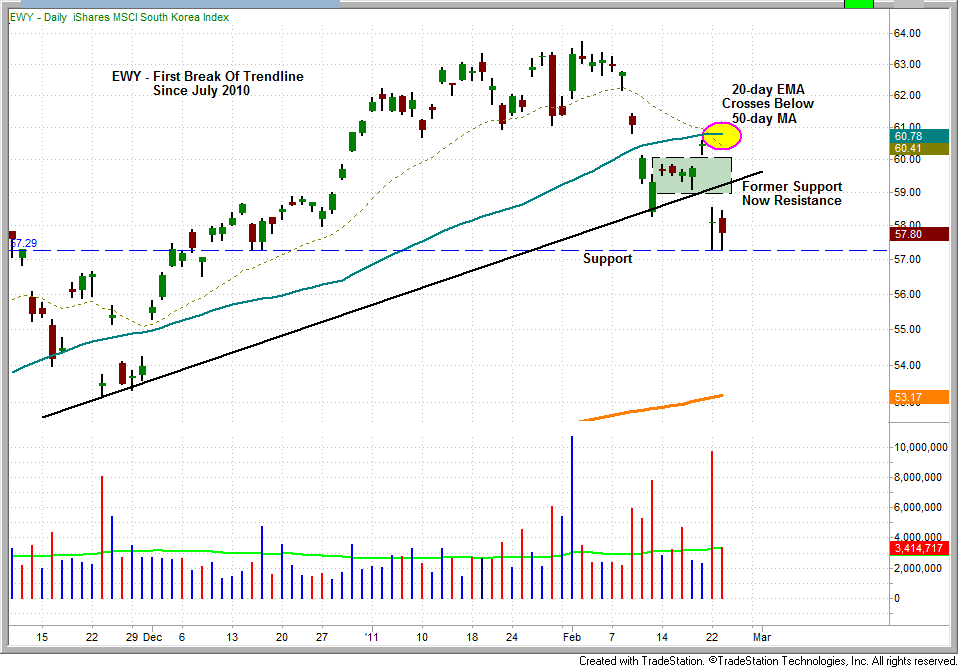| The Wagner Daily ETF Report For February 24 |
| By Deron Wagner |
Published
02/24/2011
|
Stocks
|
Unrated
|
|
|
|
The Wagner Daily ETF Report For February 24
Stocks got hit hard for a second consecutive day on Wednesday, as volume spiked. Sellers controlled the early action. However, a late session rally helped to repair some of the damage. The small-cap Russell 2000, the S&P MidCap 400 and the Nasdaq ended the day lower by 1.7%, 1.4% and 1.2% respectively. The Dow Jones Industrial Average and the S&P 500 fared somewhat better. The blue chip Dow fell 0.9%, while the S&P 500 shed 0.6%.
Market internals pointed toward a second consecutive day of distribution on Wall Street. The NYSE saw volume increase by 3.6%, while turnover on the Nasdaq ended the session almost 10% higher. In a repeat of Tuesday's action, declining volume outpaced advancing volume on both major indices. The session ended with ratio at 2 to 1 on the NYSE and 6 to 1 on the Nasdaq.
Yesterday we sent out an intraday alert notifying subscribers of a short entry in the iShares MSCI Mexico Investable Market ETF (EWW) with a tight stop just above the day's high. When volatility enters the market after an extended absence, it is often a good strategy to maintain a tight stop when trading against the broad market trend (following several days of strong distribution). This strategy is only advisable when shorting sectors or ETF classes that have been exhibiting relative weakness to the broad market. By approaching the trade this way you are protecting against big losses in the event of a major whipsaw reversal that often accompanies periods of heavy distribution. Since the ETF being traded is demonstrating relative weakness, and if the market moves severely against the trade, this exit strategy keeps losses to a minimum. Of further importance is the risk/reward ratio behind the trade. In the case of EWW we are risking a small amount to potentially make four to eight times that amount. Remember, you can always reenter the trade if the stop is hit and the reentry setup is justified. It is much more difficult for a tight stop to be taken out when an ETF is demonstrating relative weakness. Essentially, we want the trade to go in our favor quickly or we want out. This strategy only works if the potential reward is substantially higher than the potential risk (generally 4:1 or better) and the ETF is exhibiting relative weakness. In the absence of both relative weakness and a high payout potential, this strategy should not be adopted, as it would likely result in financial death "by a thousand paper cuts". The payout must be substantial enough to take into account the tight stop.

During the past two sessions of heavy market distribution, the iShares MSCI South Korea Index ETF (EWY) has broken below its trend line for the first time since last July. Further, the 20-day EMA has crossed below the 50-day MA. This is usually considered a bearish signal. The trend line break, the gap and the declining 20-day EMA now serve as resistance for EWY. A rally back into this resistance or a move below the two-day low of $57.31 could present a shorting opportunity in this ETF. We will be monitoring EWY closely for a possible short entry.

Despite the heavy two-day selloff, the market remains in an uptrend. The Dow, S&P 500 and Nasdaq all remain above their 50-day moving averages. When volatility enters the market, the rebounds can be as vicious as the selloffs.
Deron Wagner is the Founder and Head Trader of both Morpheus Capital LP, a U.S. hedge fund, and MorpheusTrading.com, a trader education firm.
|